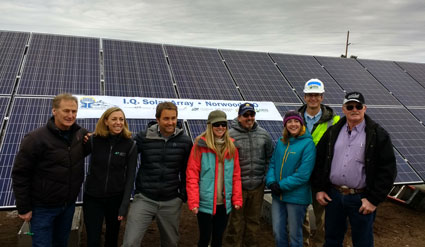Contaminated former industrial sites and landfills, often referred to as brownfields, can pose a challenge for many communities, but for renewable energy development, they might just be an opportunity.
A Colorado county’s unwavering vision to reclaim a local brownfield and turn it into a “greenfield” is coming to fruition this month, with the completion of a community solar array that will harness renewable energy and help the local community for decades to come.
The new San Miguel County solar array, made possible by a partnership between San Miguel Power Association (SMPA), the Colorado Energy Office (CEO) and GRID Alternatives, will significantly lower the electric bills of qualified low-income residents in SMPA’s territory. The project is part of a statewide initiative to reduce energy costs for utilities’ highest need customers, and will turn a limited-use brownfield site into a clean energy generator.
Undaunted by sub-freezing temperatures and snowy weather, volunteers traveled from across the state to help GRID install the array over the course of two weeks. Project participants included members of local environmental groups, community organizations, and even a group of local high school students who elected to forgo their ski day to come volunteer.
“I think [the project] is definitely going to make a difference because, for so many people who are living paycheck to paycheck, it really does help to have your utilities go down,” said Ava Gutierrez of Telluride Mountain School. “We’re just here to try to help make a difference!”
 Representatives from the Department of Energy and Environmental Protection Agency were also onsite to see the project come together. “When we see projects like this, we are filled with optimism,” said Sandy Stavnes, Acting Assistant Regional Administrator for the EPA. “With this project, community partners came together to turn property that had limited reuse potential into something that will provide energy to community members in need as well as significant environmental benefits.”
Representatives from the Department of Energy and Environmental Protection Agency were also onsite to see the project come together. “When we see projects like this, we are filled with optimism,” said Sandy Stavnes, Acting Assistant Regional Administrator for the EPA. “With this project, community partners came together to turn property that had limited reuse potential into something that will provide energy to community members in need as well as significant environmental benefits.”
This is the sixth low-income community solar demonstration project developed in partnership with local utilities through a $1.2 million grant GRID received from CEO in August 2015. Each project is piloting a slight variation on the low-income community solar model to address the unique needs of rural utility service areas and their customers.
“This project, with its multiple bottom lines—energy cost saving for families, renewable energy, brownfield reclamation, and local solar job training—is a win for the whole community and a model for the state and the nation,” said Chuck Watkins, Executive Director of GRID Alternatives Colorado.

